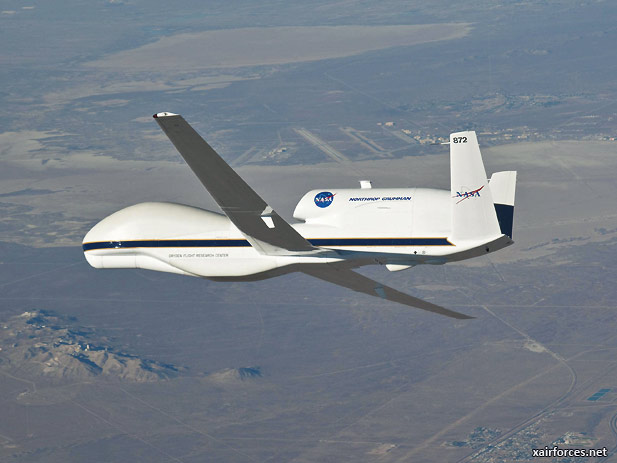
Northrop Grumman, NASA Renew Earth Science Partnership

Northrop Grumman Corporation and NASA's Dryden Flight Research Center extended the NASA Space Act Agreement and will continue sharing Northrop Grumman-produced Global Hawk unmanned aircraft for science missions and flight demonstrations, including hurricane surveillance, atmospheric research and exploration of new mission capabilities.
"In the last five years, the Global Hawk has flown over the eye of hurricanes, examined the effects of greenhouse gasses and conducted cutting-edge autonomous aerial refueling trials," said George Guerra, vice president of the Global Hawk program for Northrop Grumman's Aerospace Systems sector. "We are thrilled to continue our partnership with NASA and look forward to more scientific and technological breakthroughs in the next five years."
The agreement will continue until April 30, 2018, and allows for joint use and shared cost of the NASA Global Hawks. The initial Space Act Agreement, signed April 30, 2008, returned two preproduction Global Hawk aircraft to flight status. Under the partnership, a permanent ground control station was built at Dryden Flight Research Center, which is based at Edwards Air Force Base, Calif.
The high-altitude, long-endurance capabilities of the Global Hawk are uniquely suited to scientific research. Scientists from NASA, the National Oceanic and Atmospheric Administration and universities have capitalized on the range and dwell time of the Global Hawk.
"The Global Hawk is an invaluable asset and has changed the way we collect data and conduct Earth-science missions," said Chris Naftel, NASA Dryden Global Hawk project manager.
Access to wide areas and remote locations of the world has allowed Global Hawk to collect data for a variety of science research missions, including:
January 2013: Global Hawk started collecting atmospheric data in support of the Airborne Tropical TRopopause Experiment (ATTREX) campaign. Scientists use the data to study how the composition of the atmosphere affects Earth's climate.
Fall 2012: Supported environmental scientists during Hurricane and Severe Storm Sentinel (HS3) missions. The HS3 missions studied hurricane formation and intensity change in the Atlantic Ocean. This was the first joint NASA-Northrop Grumman deployment from the Dryden Flight Research Center.
Spring 2011: Flew winter storm missions over the Pacific and Arctic, observing, among other weather phenomena, an "atmospheric river" that sometimes causes flooding on the West Coast.
Fall 2011: Supported ATTREX missions over the Pacific by climbing and descending between 45,000 feet and 65,000 feet, gathering information on climate change due to water vapor and other aerosols.
September 2010: Supported the Genesis and Rapid Intensification Processes hurricane surveillance missions that provided extended monitoring of changes in hurricane intensity during five storms in the southern Caribbean and western Atlantic.
April 2010: Completed the first science research campaign called GloPac, studying the atmosphere over the Pacific Ocean and Arctic.
The Global Hawk is a fully autonomous, high-altitude, long-endurance unmanned aircraft system that can fly up to 65,000 feet for 30 hours at a time. Its endurance and range allow for nonstop flights from NASA Dryden in Southern California to the North Pole and remaining for up to seven hours over the polar region before returning to Dryden.
Northrop Grumman is a leading global security company providing innovative systems, products and solutions in unmanned systems, cyber, C4ISR, and logistics and modernization to government and commercial customers worldwide. Please visit www.northropgrumman.com for more information.
Source: SAN DIEGO – northropgrumman.com News - 30 May 2013
Photo: The U.S. NASA-Northrop Grumman Global Hawk aircraft in flight The Global Hawk can fly autonomously to altitudes above 60,000 feet -- roughly twice as high as a commercial airliner -- and as far as 11,000 nautical miles. Operators pre-program a flight path, and then the plane flies itself for as long as 30 hours. Credit: (Photo by NASA/Dryden/Carla Thomas)
(30.05.2013)
|